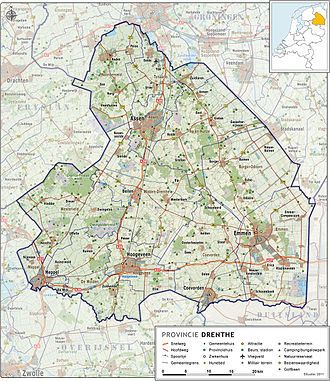- Drenthe
-
Drenthe — Province — 
Flag
Coat of armsAnthem: Mijn Drenthe Location of Drenthe in the Netherlands Country Netherlands Inclusion 1796 Capital Assen Largest city Assen Government - Queen's Commissioner Jacques Tichelaar Area - Land 2,642 km2 (1,020.1 sq mi) - Water 38 km2 (14.7 sq mi) Area rank 7th Population (2010) - Land 489,918 - Rank 10th - Density 185.4/km2 (480.3/sq mi) - Density rank 12th ISO 3166 code NL-DR Religion (2005) Protestant 22.7%
Catholic 7.6%
Muslim 1.7%Website www.drenthe.nl Drenthe
 pronunciation (help·info) is a province of the Netherlands, located in the north-east of the country. The capital city is Assen. It is bordered by Overijssel to the south, Friesland to the west, Groningen to the north, and Germany (districts of Emsland and Bentheim) to the east.
pronunciation (help·info) is a province of the Netherlands, located in the north-east of the country. The capital city is Assen. It is bordered by Overijssel to the south, Friesland to the west, Groningen to the north, and Germany (districts of Emsland and Bentheim) to the east.Contents
History
Drenthe, unlike many other parts of the Netherlands, has been a sparsely populated rural area since medieval times. Except for some industry in Assen and Emmen, the lands in Drenthe are mainly used for farming.
Drenthe has been populated by people since prehistory. Artifacts from the Wolstonian Stage (150.000 years ago) are among the oldest found in the Netherlands. In fact it was one of the most densely populated areas of the Netherlands until the Bronze Age. Most tangible evidence of this are the dolmens (hunebedden) built around 3500 BC, 53 of the 54 dolmens in the Netherlands can be found in Drenthe, concentrated in the northeast of the province.
Drenthe was first mentioned in a document from the year 820, it was called Pago Treanth (district Drenthe). In archives from "Het Utrechts Archief" from 1024 to 1025 the "county Drenthe" is mentioned, when Emperor Henry II gave it to Bishop Adalbold II of Utrecht.
After long being subject to the Utrecht diocese, Bishop Henry of Wittelsbach in 1528 ceded Drenthe to Emperor Charles V of Habsburg, who incorporated it into the Habsburg Netherlands. When the Republic of the Seven United Provinces was declared in 1581, Drenthe became part of it, although it did not gain provincial status until January 1, 1796 due to its poverty.
Shortly before the outbreak of the Second World War, the Dutch government built a camp near the town of Hooghalen to accommodate German (Jewish) refugees. Ironically, during the Second World War, the German occupiers used the camp (which they named KZ Westerbork) as a "Durchgangslager" (transit camp). Many Dutch Jews, Sinti, Roma, resistance combatants and political adversaries were imprisoned before being transferred to other camps in Germany and Poland. Anne Frank was deported on the last train from Westerbork.
The name of this region is said to stem from *thrija-hantja "three lands".
Politics
The provincial council (Provinciale Staten) has 51 seats, and is headed by the Queen's Commissioner, currently Jacques Tichelaar. While the provincial council is elected by the inhabitants, the Commissioner is appointed by the Queen and the cabinet of the Netherlands. With 19 seats, the social democratic PvdA is the largest party in the council. The daily affairs of the province are taken care of by the Gedeputeerde Staten, which are also headed by the Commissioner; its members (gedeputeerden) can be compared with ministers.
Municipalities
Due to reorganisations in the 1990s, the number of municipalities in Drenthe has been reduced to twelve. Most municipalities therefore now consist of several towns and villages.
Geography
Besides the capital Assen, Emmen, Meppel and Hoogeveen are the major urban centres of the province. Drenthe, consisting mostly of heathland, has no significant rivers or lakes.
Economy
Agriculture is an important employer, although industrial areas are found near the cities. The quietness of the province is also attracting a growing number of tourists.
Drenthe is known as the "Cycling Province" of the Netherlands and is an exceptional place for a cycling holiday, having hundreds of kilometres of cycle paths through forest, heath and along canals and many towns and villages offering refreshment along the way.
Language
Over half the population of Drenthe speaks the Drents language. Each town or village has its own version. All versions are part of the Low Saxon language group. Dutch Low Saxon has been officially recognised by the Dutch government as a regional language and is protected by the European Charter for Regional or Minority Languages.
External links
- Official website
- The Drentse Fietsvierdaagse, the most famous of all fietsvierdaagses of the Netherlands.
 Provinces of the NetherlandsProvinces
Provinces of the NetherlandsProvincesDrenthe · Flevoland · Friesland · Gelderland · Groningen · Limburg · North Brabant · North Holland · Overijssel · South Holland · Utrecht · Zeeland
 Burgundian Circle (1512–1806) of the Holy Roman EmpireRemained
Burgundian Circle (1512–1806) of the Holy Roman EmpireRemained
County Imperial City Besançon3Dependent territories 1 until 1648; 2 until 1659; 3 until 1678. Categories:- Provinces of the Netherlands
- Drenthe
- NUTS 2 statistical regions of the European Union
- Seventeen Provinces
- Burgundian Circle
Wikimedia Foundation. 2010.





